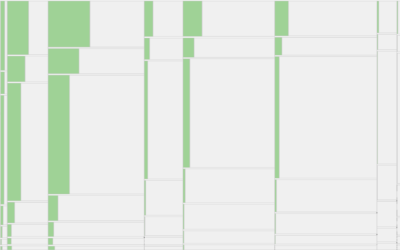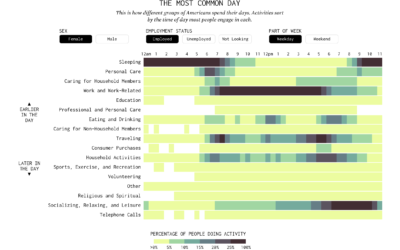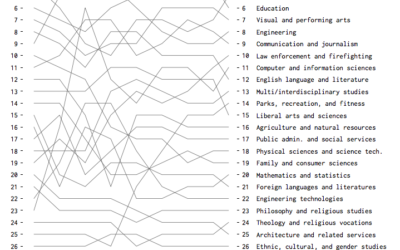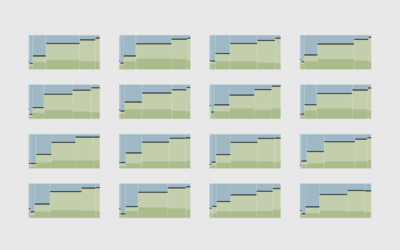From Herald Daily is this giganto view of land mass and population size by country.
I’m not sure how I feel about this one. I mean, it’s basically population density, but it’s separating population and area and then comparing the two. Then the population circles are sized based on 1,000 people per square mile which seems like it was more out of convenience than anything else.
What do you think – does this graphic work? Leave your thoughts in the comments below.
[via FlowingData Flickr Group]







I think it would look better if there was some sort of bacon-themed chart next to it.
LOL – anyhow I found it a tasty chart
Yay, bacon!
Or beer. Yay, beer!
I would like the option to re-order the list based on population instead of landmass. (e.g., large Orange dots at the top). Or at a minimum, put the population rank in parenthesis, e.g., for Indonesia: 229,965,000 (4th)
Bangladesh, Philippines missing considering its smaller size and huge population.
I believe there is an error in your Brazil/Australia calculation regarding land mass size and the size of the white circle.
I think the graphic would work better if you could represent each country by it’s shape, and then size a similar country shape to show population inside the country. Also, see if you can get accurate “per sq ft owned per person” or some similar measure to size the second shape displaying population. Then you would see how dispraportionately (sp?) the US population is in terms of area of the country that is being used vs. countries like China and India where people have a much smaller “footprint” in terms of used space. Maybe carbon footprint for the sizing? Or avg. annual wage?
The size and rank of the Brazil land-area circle looks about right, but the number is way off; it’s up in the 8 million sq km range, not 3 million.
Despite data inaccuracies, I do think it’s a pretty interesting way to quickly and briefly show these comparisons. It’s an easy to take in/understand method of portraying this concept which is enhanced by its visual simplicity. I can take it for what it is, basically.
Yeah…the Brazil number label is off (looks like sq miles was used instead of sqkm) but the visual proportions are correct.
The ranking is tough to call between the US and China:
http://en.wikipedia.org/wiki/List_of_countries_and_outlying_territories_by_total_area
I honestly don’t think populations should be circles, they should be pie slices. I mean, is it readily apparent to you that China has 4 times more people than the US from this graphic? I always thought that the square relationship between radius and area in circles made them a little bit more difficult for comparing sizes, but maybe it’s just me.
I think this is a great point. I was thinking along similar lines, but Matt put it quite well.
The pie slices wouldn’t look as “fun” as the egg yolks, but it would be more informative.
How about a simple X/Y graph? Mess with the scale until most countries hover around the X=Y line and see which ones are the most divergent.
Came here to say this. Graphs using full circles for area to compare values always fail (for me, anyhow). I think most humans are bad at properly comparing the area of two circles, because you can’t visually pack circle in the other and see the remainder as a single circle.
Look at India above, for example, where it appears that the outer circle has about twice the radius of the inner. Can you tell me that you can see that three of those inner orange circles could be put in the remaining whitespace?
And then there’s the confusion of whether it’s the area or radius being used for comparison.
agreed. best to align on an edge, in order of relative values (either population or area, but NOT centered randomly). How about arrange in order of decreasing area along one line, then repeat the series along another line above the first, in order of increasing population, centered on at least one record point.
China makes for the best fried egg.
India makes for the best hard boiled egg.
it doesn’t quite work for me. Several reasons – first, the size is way too large, I can only keep about 5 items on the screen at the same time. By the time I’ve zoomed far out to be able to see all items, I can’t read the text, and the relation is lost for smaller populations – they all look the same.
In fact, displaying those quantities in that kind of scale only works to show the massive differences between the outliers. Comparing any two other items is a pain – looking at, say, Kazakhstan and Saudi Arabia, I am vaguely aware that the former should be slightly more spacious than the latter, but have absolutely no intuitive feel by how much..
To fix, rather than completely redo, the visualization, I would probably display it in 3 rows of circles. First row would be the area, with the name of the country inside, possibly numeric area too. Second row below would be the circles for population size
and third row would be the ratio of population by area – so in essence display the “personal space” available to each person
and would probably need to drop Greenland out of the third row, or represent as a dashed part of a massive circle, otherwise it would completely obliterate the rest of the display
I’d like to see the same using inhabitable land mass
mistake: Congo has a population 20+ times what you ascribed to it.
“I’d like to see the same using inhabitable land mass” Yeah — me too — or arable land v. population. India has a lot of mountains that you can’t do much with, for example.
I agree with the comments about usable land mass, although India would probably look might more tight than it does right now.
Hard to calculate usable land mass in a consistent way, however. Some areas (like the US) won’t allow building in wetlands, while other countries have virtually no restrictions on such habitations.
2d dpd at 6:09. Appears that area of Congo-Kinshasa (nee Zaire, ex-Belgian) was mixed with population of Congo-Brazzaville (or the Republic of the Congo, ex-French)
We need some relativization here. Seems like there’s room for everybody even in Japan.
I think that a good starting point could have been making an average of the world, so we’d be able to tell if a country is more populated than the other. Sorry, couldn’t make myself clear, but maybe I’ll create my own version in my spare time.
Pingback: Lesezeichen vom 13. November 2009 | PolkaRobot
since they all look like breasts, why not find photos of appropriately sized breasts with nipple to breast ratios for the visuals?
you should do america without alaska, also. Alaska I think really changes everything. We would then be able to compare these various circles with our daily lives better.
In that case, wouldn’t one also do Russia without Siberia? Or Canada without the Northwest Territories? Or Greenland without… um, Greenland?
i’d like to see the smaller landmass countries with large populations compared
This seems very meaningless without the European countries included: it would helpful to know where they sit in this spectrum.
—————————
Another approach would equalize the size of the white circles, showing only the differences in population density.
Pingback: Rashtrakut » Blog Archive » Population and Landmass
The design needs a little work to make it a bit clearer: I know the speech bubbles point to the correct graphics, but if you miss them it looks a bit confusing: is the first country Canada, or is it Russia? If you scroll down the image, you can deduce that it’s Russia, but the text could align uniformly with the circles (or boobs if you prefer), eliminating ambiguity.
I think you would find if you did Japan that the result might be more extreme
It gives kind of an odd impression of Canada, because something like 90% of Canada’s population lives within 50 miles of the US border.
Other interesting maps, allowing you to compare population size by country, though the relation between landmass and population is gone:
– http://img267.imageshack.us/img267/2208/worldpopmap6kv.jpg
– http://www.odt.org/Pictures/poplcart.jpg
Couple of thoughts: this comparison is most interesting to see which countries are bursting at the seems, and which have lots of absoprtion capacity. That means, as some other poster have pointed out, that we need to see both the countries with big white dots and with big yellow dots.
For me, the most fascinating would be to ask, how much land does one person need, if you add up the space needed for decent housing, santitation, energy generation, work space (office, factory, etc.) and land to grow food. And the comparison would be ideally against habitable land – e.g. Greenland and Australia are in practical terms much smaller physically than their landmass would suggest.
Graphic is OK, but it makes the comparison piece harder, which is the most interesting question. Also, how would you show a country where there is a bigger population than there is habitable land to support it (I’m thinking Bangladesh, here)?
M
I agree, the “land per person” comparison would make this a whole lot more useful. It’s kind of meaningless to compare people and sq km without knowing what the relationship is between the two. The question that springs to my mind is something like “is China full yet?” The graphic doesn’t answer that
While I do like where the graph is headed and it does give a compelling story. But from a population density perspective I think its flawed, especially when you add in countries like Japan and Taiwan because much of their urban areas have learned to build vertically to make up for the lack of land space. I would suspect that the orange part of the graph will overtake the white in such cases. Which may break the story.
I like the visual style, very attractive and catchy – specially when comparing multiple items, not so much when analysing one at a time. But they give a wrong impression: that of countries getting “full”.
In a certain sense, a higher population density (bigger yellow circle) means that the country is getting “fuller”. But if the population density gets large enough for the yellow circle to match the size of the white circle, this doesn’t mean that there is no more physical space available to hold people. In that sense, they give a wrong impression.
This sort of visualization seems to be more suited for percentages, e.g. % of alcohol in beverages. White circle = total mililiter of beverage, yellow circle = pure alcohol in mililiter.
Hope this isn’t too picky, but hey, this is a detail-oriented site about graphing…
The units of landmass are “square kilometers,” but the legend describes this as “sq/km.” Clearly no division in those units, so take out the slash.
The individual nation descriptions have it right.
india looks yummy
I think using a global elevation data set and calculating slope might get an estimate of livable land, presuming people can’t build on a certain percent slope. Not entirely accurate but a good starting point. Also taking out all the water bodies would be another way to remove land that isn’t usable.
Just some thoughts.
I’m not sure what story this tells. Should the countries with lot’s of land start spreading their population out? India is the only one that is interesting at all.
Pingback: STNDE | LAND MASS | 人å£å¯†åº¦ã‚’ビジュアライズ
Eye-catching and ineffective, like so many other info visualizations.
Bubbles, we’ve beaten to death the problems with encoding values using area.
Why the recent infatuation with ten foot tall (sorry, that’s ten meters for you non-USians) graphics. By the time I scroll down a screen, I’ve already conveniently forgotten what I saw a moment ago.
To actually display the data, a bar chart or dot plot would work best. Or maybe two, one sorted by area, the other by population. Throw in a third with population density, just for fun. Make one yellow, another orange, and the third the color of bacon.
graphics made completely for the digg crowd.
Pingback: Infographic eye candy roundup : Lauren Rae Orsini